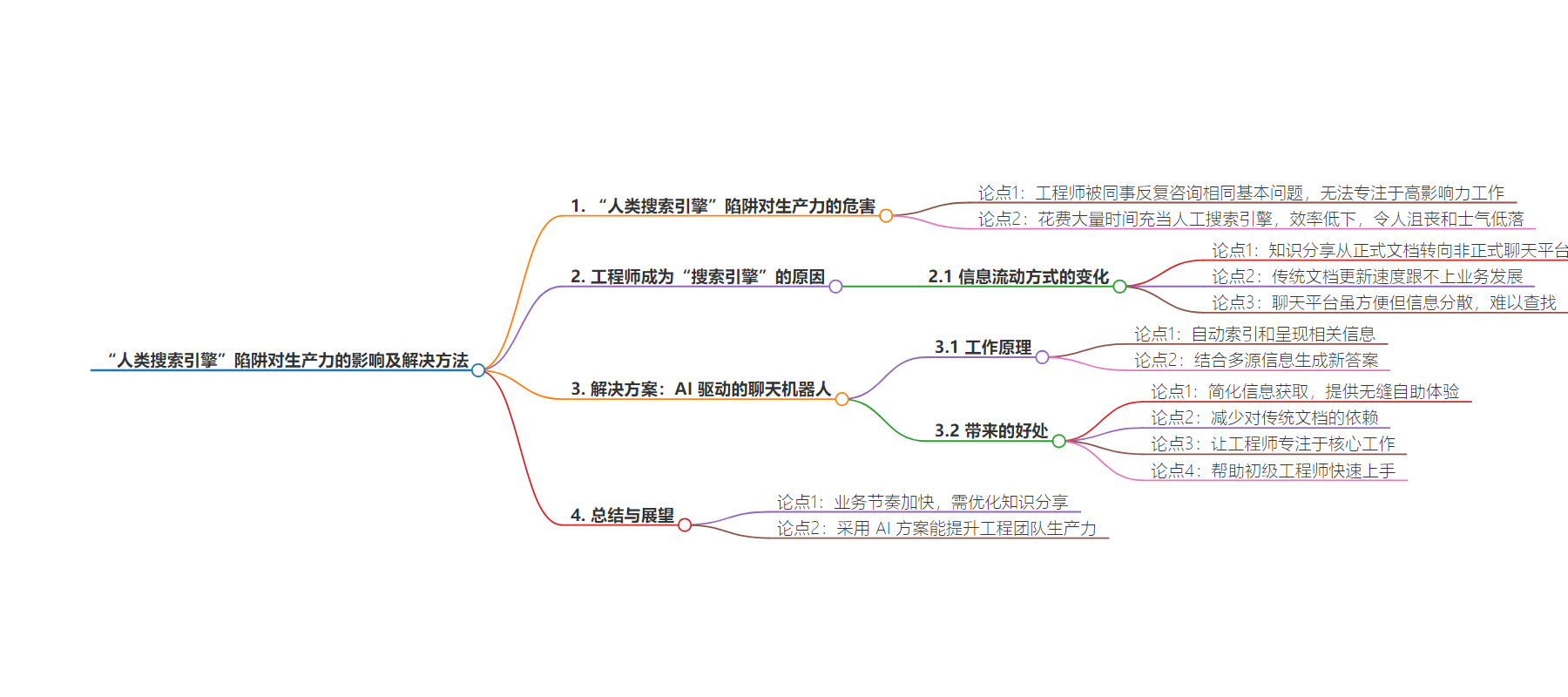包阅导读总结
1. 关键词:
– 人类搜索引擎陷阱
– 团队生产力
– 知识分享
– AI 聊天机器人
– 工程效率
2. 总结:
本文探讨了“人类搜索引擎”陷阱对工程团队生产力的影响,指出其根源在于信息流动方式,提出借助 AI 聊天机器人实现知识自动化,简化信息获取,解放人力专注核心工作,加速信息循环,提升工程效率。
3. 主要内容:
– 人类搜索引擎陷阱降低工程团队生产力
– 工程师被频繁咨询基础问题,无暇专注高价值工作
– 工程师成为搜索引擎的原因
– 知识分享从正式文档转向非正式聊天平台,信息分散且难以查找
– 解决方案:AI 聊天机器人实现知识自动化
– 自动索引和提供相关信息,准确回答常见问题
– 减少对传统文档的依赖,节省人力和时间
– 知识自动化的效果
– 提升信息获取效率,用户体验无缝自助
– 解放人力专注复杂问题和创新
– 帮助初级工程师快速成长
– 呼吁采用 AI 解决方案提升效率
– 避免团队被频繁打断,确保高效知识分享和高价值工作
思维导图:
文章地址:https://thenewstack.io/how-the-human-search-engine-trap-killed-productivity/
文章来源:thenewstack.io
作者:Dev Nag
发布时间:2024/6/14 16:18
语言:英文
总字数:653字
预计阅读时间:3分钟
评分:86分
标签:赞助商-querypal,赞助文章-贡献
以下为原文内容
本内容来源于用户推荐转载,旨在分享知识与观点,如有侵权请联系删除 联系邮箱 media@ilingban.com
In today’s fast-paced tech world, there’s a silent killer stalking your engineering team’s productivity: the “human search engine” trap. Picture this: your top engineers, the ones you rely on to innovate and solve complex problems, are constantly bombarded with messages from their colleagues asking the same basic questions over and over again. “Hey, how do I set up this database connection?” “What’s the process for deploying this service?” “Where can I find the documentation for this API?”
Instead of focusing on high-impact work, these crucial, well-paid team members spend a significant portion of time serving as human search engines, manually pointing their colleagues to the right documentation or, worse, repeatedly answering the same questions ad nauseam. It’s a frustrating, demoralizing and incredibly inefficient cycle that’s killing your team’s productivity.
How Did Engineers Turn Into Search Engines?
The root cause of this problem lies in how information now flows within organizations. Over the past decade, the primary medium for knowledge sharing moved from formal documentation to informal chat platforms like Slack and Microsoft Teams. The reason is traditional documentation can’t keep pace with the ever-accelerating speed of business. By the time someone writes up a comprehensive knowledge-base article, the information is already stale.
Chat, on the other hand, allows real-time collaboration and knowledge sharing at the speed of modern business. Got a question? Just ping your colleague and get an instant response. No need to spend hours digging through outdated wikis or readme files. But this convenience comes at a cost: important information is scattered across thousands of chat messages and threads, making it difficult for people to find what they need. And so, the cycle of interruptions and human search engines began.
Fortunately, there’s a solution: AI-powered chatbots that leverage advanced techniques like retrieval-augmented generation (RAG) and large language models (LLMs). These intelligent assistants can automatically index and surface relevant information from your team’s chat history, documentation and other knowledge bases, and provide instant, accurate answers to common questions right within the chat interface. They don’t manage knowledge transfer; they automate it.
How Knowledge Automation Simplifies Information Acquisition
Here’s how it works: When a user asks a question in Slack, the AI chatbot automatically searches through all the indexed information to find the most relevant answer. If the question has been asked before, it can pull the response directly from the chat history. If not, it can combine information from multiple sources to generate a new answer. The result is a seamless, self-serve experience for the user, without interrupting their colleagues.
We’ve found that most questions posed in team chat have already been answered before. By shortcutting the information flow from historical Slack conversations straight into future Slack questions, this AI-powered approach to knowledge automation minimizes the need for the traditional documentation cycle, which results in extra work to produce outdated information.
It also frees the “human search engines” on your team to focus on what they do best: solving complex problems and driving innovation. And as a bonus, the AI chatbot acts as a tireless, always-available mentor, helping junior engineers get up to speed quickly without constantly pinging their more experienced colleagues.
This AI-driven solution massively accelerates and tightens up your team’s information loop without allocating precious time and resources to patch a broken knowledge-sharing system. It’s a game-changer for engineering productivity in the age of real-time collaboration.
Streamline Knowledge Sharing
The world isn’t going to slow down. And as the pace of business continues to accelerate, the “human search engine” trap threatens to become more acute. Adopting AI-powered solutions helps streamline knowledge sharing and keep engineering teams focused on high-impact work. The alternative is a death by a thousand interruptions, with your most valuable engineers reduced to little more than walking, talking search bars.
YOUTUBE.COM/THENEWSTACK
Tech moves fast, don’t miss an episode. Subscribe to our YouTubechannel to stream all our podcasts, interviews, demos, and more.
